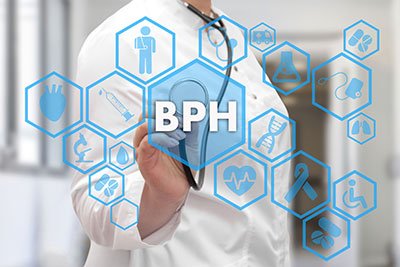Prostate gland enlargement is a problem commonly faced by elderly males. It is found to cause profoundly troublesome symptoms related to urination however the important point to understand here is that benign prostatic hyperplasia (BPH) is a completely separate entity and it never progresses to prostate cancer. The epidemiologic data collected suggest that the risk of developing this condition is increased several folds with every decade of life after you turn to the age of 50 years.
The prostate is a tiny gland roughly about the size of the walnut that is located just beneath the bladder. The anatomic location of the urethra or the tube that carries urine stored in the bladder and takes it out of the body at the penis is such that it passes right through the center of this prostate gland. This is why any enlargement of the prostate gland exerts a pressure on the urethra, interfering with the smooth flow of urine through it, thus producing all the troublesome urinary symptoms associated with benign prostatic hyperplasia as we will see in a bit.

Initially, the symptoms of benign prostatic hyperplasia are mild but with the advancement of age, there is worsening of the symptoms. The symptoms commonly seen in patients with enlargement of the prostate gland are summarized here
One more thing, the severity of the symptoms is not related to the degree of enlargement of the gland. It may seem counter-intuitive but some patients with only moderate enlargement of the prostate gland can have significant symptoms while the other patients are usually stable with only a few symptoms despite having a markedly enlarged gland.
There are drugs as well as different surgical procedures available for the treatment of BPH.
There are alpha receptors located on the neck of the urinary bladder. These receptors, when stimulated by adrenaline, causes constriction of the bladder neck and when the bladder neck constricts, urine cannot go out of the bladder. Alpha blocker inhibits the action of adrenaline on these receptors. Thus, the bladder neck no longer contracts, rather it relaxes. This helps the passage of urine out of the bladder, thus providing relief to the patient. The commonly included drugs in this group are erazosin, doxazosin tamsulosin, alfuzosin, and silodosin.
Benign prostatic hyperplasia is believed to be caused by an excess of a chemical called dihydrotestosterone that is formed when an enzyme called 5-alpha reductase acts on the testosterone. Thus, 5 alpha-reductase inhibitors block the action of this enzyme and decrease the production of dihydrotestosterone that causes shrinkage of the prostate gland over the period of time, thereby relieving the symptoms of the patient.
The patient with benign prostatic hyperplasia may be advised one of the many available surgical procedures if he is not responding to medical therapy.
Do you suffer from benign prostatic hyperplasia? Come to Century Medical and Dental Center (Downtown Brooklyn, Gravesend, Flatbush, Fort Greene and Midtown Manhattan) and to get advice on the best treatment options.
SHARE THIS POST Page Updated on Apr 10, 2025 by Dr. Dvorkina (Primary Care Doctor) of Century Medical & Dental CenterCentury Medical and Dental Center is an accredited healthcare facility in NY that operates in accordance with Article 28, a public health law. This law regulates and recognizes accreditation for public healthcare facilities, ensuring they are licensed and operated correctly. By undergoing the Article 28 process and achieving accreditation, Century Medical and Dental Center demonstrates its commitment to meeting the highest standards of care.
As a multidisciplinary medical center, we have highly qualified doctors, nurses, and support staff who are working hard to provide the best medical care to patients in Midtown Manhattan, NY, Downtown Brooklyn, NY, including Brooklyn Heights, Dumbo, Prospect Heights, Park Slope, Clinton Hill, Boerum Hill, Red Hook, Harlem, Gravesneck, Flatbush, and Bedford-Stuyvesant.